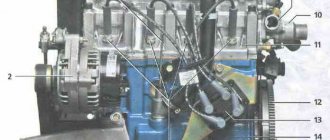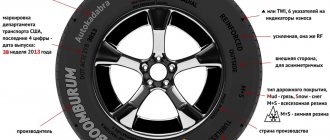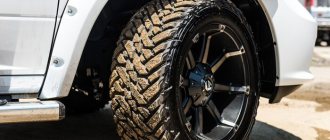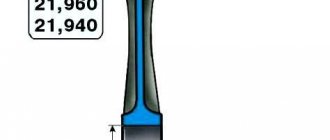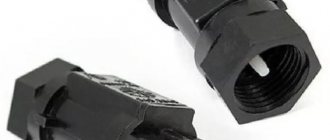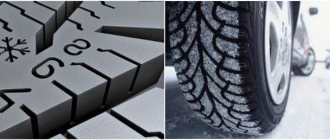Do you want to choose a tire for your car, but are not well versed in tire labeling? It's not a problem! In this section, we will help you figure out what tire parameters are, what they mean, and which tire is suitable for your car.
Decoding tire markings.
195/65 R15 91 T XL
195 is the width of the tire in mm.
65 - Proportionality, i.e. ratio of profile height to width. In our case it is 65%. Simply put, with the same width, the larger this indicator, the higher the tire will be and vice versa. Usually this value is simply called “profile”.
Since the tire profile is a relative value, it is important to take into account when selecting tires that if instead of size 195/65 R15 you want to install tires with size 205/65 R15, then not only the width of the tire will increase, but also the height! Which is unacceptable in most cases! (except for cases when both of these standard sizes are indicated in the car’s operating book). You can calculate exact data on changes in external wheel dimensions in a special tire calculator.
If this ratio is not specified (for example, 185/R14C), then it is equal to 80-82% and the tire is called full-profile. Reinforced tires with this marking are usually used on minibuses and light trucks, where a large maximum load on the wheel is very important.
R stands for radial tire (in fact, almost all tires are made this way now).
Many people mistakenly believe that R- means radius of the tire, but this is precisely the radial design of the tire. There is also a diagonal design (denoted by the letter D), but recently it has practically not been produced, since its performance characteristics are noticeably worse.
15 — wheel (disk) diameter in inches. (It’s the diameter, not the radius! This is also a common mistake). This is the “fitting” diameter of the tire on the disk, i.e. This is the inner size of the tire or the outer size of the rim.
91 — load index. This is the level of maximum permissible load on one wheel. For passenger cars, it is usually done with a reserve and is not a decisive factor when choosing tires (in our case, ID - 91 - 670 kg). For minibuses and small trucks, this parameter is very important and must be observed.
Tire load index table:
T is the tire speed index. The larger it is, the higher the speed you can drive on a given tire (in our case IS - N - up to 210 km/h). Speaking about the tire speed index, I would like to note that with this parameter the tire manufacturer guarantees normal operation of the tire when the car is constantly moving at the specified speed for several hours.
Speed index table:
American tire markings:
There are two different markings for American tires. The first is very similar to the European one, only the letters “P” (Passanger - for a passenger car) or “LT” (Light Truck) are placed in front of the standard size. For example: P 195/60 R 14 or LT 235/75 R15. And another tire marking, which is fundamentally different from the European one.
For example: 31×10.5 R15 (corresponds to European standard size 265/75 R15)
31 is the outer diameter of the tire in inches. 10.5 - tire width in inches. R is a radial tire (older tire models had a diagonal design). 15 is the inner diameter of the tire in inches.
Generally speaking, apart from the unusual inches for us, the American tire markings are logical and more understandable, unlike the European ones, where the tire profile height is not constant and depends on the width of the tire. And here everything is simple with decoding: the first number of the standard size is the outer diameter, the second is the width, the third is the inner diameter.
Additional information indicated in the markings on the sidewall of the tire:
XL or Extra Load is a reinforced tire, the load index of which is 3 units higher than that of conventional tires of the same size. In other words, if a given tire has a load index of 91 marked XL or Extra Load, this means that with this index, the tire can withstand a maximum load of 670 kg instead of 615 kg (see table of tire load indexes).
M+S or tire marking M&S (Mud + Snow) - mud plus snow and means that the tires are all-season or winter. Many summer SUV tires will say M&S on them. However, these tires cannot be used in winter, because... winter tires have a completely different rubber composition and tread pattern, and the M&S badge indicates good cross-country ability of the tire.
All Season or AS all-season tires. Aw (Any Weather) - Any weather.
Pictogram * (snowflake) - tires are intended for use in harsh winter conditions. If there is no this marking on the sidewall of the tire, then this tire is intended for use only in summer conditions.
Aquatred, Aquacontact, Rain, Water, Aqua or pictogram (umbrella) are special rain tires.
Outside and Inside ; asymmetrical tires, i.e. It is important not to confuse which side is external and which internal. When installing, the inscription Outside should be on the outside of the car, and Inside should be on the inside.
RSC (RunFlat System Component) - RunFlat tires are tires on which you can continue driving a car at a speed of no more than 80 km/h with a COMPLETE loss of pressure in the tire (due to a puncture or cut). On these tires, depending on the manufacturer's recommendations, you can drive from 50 to 150 km. Different tire manufacturers use different designations for RSC technology. For example: Bridgestone RFT, Continental SSR, Goodyear RunOnFlat, Nokian Run Flat, Michelin ZP, etc.
Rotation or arrow, this marking on the sidewall of the tire indicates a directional tire. When installing a tire, you must strictly observe the direction of rotation of the wheel indicated by the arrow.
Tubeless is a tubeless tire. If this inscription is missing, the tire can only be used with a tube. Tube Type - means that this tire must be used only with a tube.
Max Pressure ; maximum permissible tire pressure. Max Load - maximum permissible load on each vehicle wheel, in kg.
Reinforced or the letters RF in the size (for example 195/70 R15RF) mean that this is a reinforced tire (6 layers). The letter C at the end of the size (for example 195/70 R15C) indicates a truck tire (8 plies).
Radial - this marking on the tire in the standard size means that it is a tire of radial design. Steel means that the tire has a metal cord in its construction.
Letter E (circled) - the tire meets the European requirements of ECE (Economic Commission for Europe). DOT (Department of Transportation - US Department of Transportation) - American quality standard.
Temperature A, B or C is the heat resistance of tires at high speeds on a test bench (A is the best indicator).
Traction A, B or C - the tire's ability to brake on a wet road surface.
Treadwear ; relative expected mileage compared to a specific US standard test.
TWI (Tread Wear Indiration) - indicators of tire tread wear indicators. The marking on the TWI wheel may also include an arrow. The indicators are located evenly in eight or six places around the entire circumference of the tire and indicate the minimum permissible tread depth. The wear indicator is made in the form of a protrusion with a height of 1.6 mm (the minimum tread size for light cars) and is located in the tread recess (usually in the drainage grooves).
Country and manufacturing company
All manufacturers put their logo and name on the side of the wheel.
Many companies have factories in different countries, and the quality of their products can vary significantly. For example, Japanese Bridgestone tires can be produced in Italy, France, Finland, Thailand, Malaysia and many other countries.
Some tires have the inscription “Made in...”, but if it is not there, you can find out in which country the tires were produced by the DOT code. Thanks to it, you can also find out the series, plant and date of manufacture of a specific item.
The country of origin is encrypted in the form of 2 letters, which are located immediately after the abbreviation DOT. For example:
Each manufacturer has its own system for naming its factories. This is how the famous Bridgestone brand puts such codes on board
- 1D; EH; EJ; EK; EL; EM; EN; EP; H4 – country of origin: Japan;
- 0B; 0W; 1C; 2C; 2M; 3M; 4D; 5D; 7B; 8B; D2; HY; VA; VD; VE; W1; W2 – USA;
- 1U – China;
- 1V,A7 – Thailand;
- 3Y,7G, E2–Poland;
- 5T, 6T – Brazil;
- VN, 9B – Canada;
- A8 – Indonesia;
- J2 – Singapore;
- L5 – Türkiye;
- LH–Australia.
Additional markings on car tires
When designating summer and winter tires, the manufacturer can sometimes indicate additional data about the quality and characteristics of its product.
The following markings exist:
- TUBELESS
- this marker means that the tire is tubeless. - TUBE TYPE (or TT, Mit Schlauch for rubber from Germany)
is a tire that requires the installation of a tube. - Manufacturer country
. In addition to the name of the manufacturer, the country is also written on some tires. - Marking on the outside and inside
. If the tire is asymmetrical, then on its outer side there will be the word OUTSIDE (sometimes Side Facing Out), and on the inside - INSIDE (sometimes Side Facing Inwards). - Left or Right
. In the first option, tires can only be installed on the left side of the car, in the second - only on the right. - Direction of rotation
. To do this, use the designation Rotation and an arrow that indicates the direction of rotation of the wheel when moving forward. - XL (Extra Load)
- reinforced tire. - DA or Secunda (stamp)
- these marks are placed on tires with minor defects obtained during the production process that do not affect normal operation. - Green X, Reduces CO2
- designation of rubber with a low level of rolling resistance, which helps reduce fuel consumption and exhaust emissions (so-called “green tires”). - ND (Non Directional)
- rubber with a non-directional tread pattern. - What does the H mean on NHS (Non Highway Service) tires
? These are tires for low speed driving. - SAG (Super All Grip)
- all-terrain tires. - SUV (Sport Utility VehiCles)
- tires designed for heavy all-wheel drive crossovers and sports SUVs. - REGROOVABLE
- the ability to deepen the tread pattern by cutting. - RETREAD
- tires restored after wear. - Studless
- cannot be studded. - Studdable
- subject to studding. Marking for winter tires. - Studded
- studded tires.
We recommend
“How much does a timing belt cost: choosing the best manufacturers” Read more
Model and tread type
In addition to the brand name, manufacturers indicate its model on the tire. Most brands have several model series (or lines), which differ:
- tread pattern and type;
- composition of the material used;
- purpose;
- seasonality.
Within one model, the buyer can choose the diameter and wheel profile that suits him.
Each line is designed for a specific user, for whom speed, durability or economy are important. For example, Michelin has in its range the Energy model, which is environmentally friendly and saves fuel.
For lovers of fast and hard driving, the Michelin Primacy model is designed, providing a high speed index and controllability during maneuvers.
The model name has numbers and letters. They are written immediately after the name of the manufacturer.
By the name of the model it is easy to determine the pattern and type of tread.
The tread with a directional surface has an arrow indicating the direction of rotation and the inscription “Rotation”. Asymmetrical tires are equipped with Outside and Inside markers, which help to mount the tires correctly.
Tire markings: general information
On the side of any tire you can find a combination of different symbols: letters, numbers, various icons, etc. By understanding the meaning of each mark, you can get the most detailed information about the tire.
What do the numbers and letters on tires mean? Here are the main values:
- Model or brand name.
- Manufacturer.
- Tire size.
- Speed index.
- Ultimate load index.
Let's take a closer look at what information the letters on tires hide and what other symbols mean.
1. Manufacturer.
The name of the tire manufacturer is usually written in capital letters. This is done solely for brand advertising. Many companies develop their own unique logo that marks all products. There are a great many manufacturers of car tires, so we will not list them.
2. Brand or line.
Tire companies typically have several brands in their inventory. Tires are produced under one label or another in several models and series. Within one series, you can see products that differ in size and characteristics, which greatly facilitates and expands the choice.
3. Tire size.
The most important criterion for choosing tires is the size; it is indicated in the form of letters and numbers. Let's take the 195/60R14 marking as an example.
By 195 mm we define the width of the tire profile. In other words, this is the distance between the outermost edges of the side parts of a tire inflated with air (without taking into account protective belts, other markings, etc.).
The number 60 means the ratio of the profile height to its width. It is expressed as a percentage. In this particular case: 195*0.6=117 mm.
The English letter R (short for Radial) means radial type of tire. This type of tire is considered one of the most popular; it has long surpassed the old diagonal type.
And the last indicator - 14 - informs the tire buyer about its mounting diameter (rim Ø), expressed in inches. Sometimes the letter C is added after the diameter value (short for commercial), this means that during production, the tire was equipped with an additional ply standard. These products are approved for use on minibuses, trucks or vans. The load capacity index of reinforced tires is indicated by two numbers, the first means the permitted load on a single tire, and the second - on a double one.
American-made car tires have an alternative designation system that is slightly different from the standard. As an example, consider this option: 35/12.5 R15 113Q. In this case, 35 means the outside diameter of the tire (expressed in inches). 12.5 - width (in inches). The remaining symbols correspond to the standard symbols described above. The only difference is that all measurements are indicated not in millimeters, but in inches.
4. Index of the maximum permissible load on the tire (Load Index).
This indicator means the permitted maximum load on a particular tire model. This value looks like a numeric code, in which there is no specific data on the permissible weight. To determine the approximate load index, you need to divide the total weight of the machine by four. Lodal Index is usually indicated after the tire size.
The permissible load coefficient or index is indicated by a number in the range from 0 to 130, the most common values: from 71 to 110. Each combination means its own permissible load.
It should be taken into account that this is an indicator only of the permissible weight of tires, without specifying the specific type of car or the conditions of its use. Among other things, tires should not be used at their maximum capacity, that is, at a constant maximum load. It is important for car owners not to allow the load to exceed 80% of the specified data. For SUV drivers, the limit is 70%.
5. Speed index.
This data is presented in the form of letters of the English alphabet. Below we will talk about their meaning in more detail.
We recommend
“How to store tires: summer tires in winter, and winter tires in summer” Read more
Speed limit of car tires
The correspondence to the speed designation of its indicators can be found in the table:
| Maximum speed (km/h) | Speed index |
| 120 | L |
| 130 | M |
| 140 | N |
| 150 | R |
| 160 | Q |
| 170 | R |
| 180 | S |
| 190 | T |
| 200 | U |
| 210 | N |
| 240 | V |
| 270 | W |
| 300 | Y |
| More than 300 | Z |
The marking indicates what the highest speed can be achieved on certain tires. It looks like Latin letters and is indicated on the side of the tire.
Maximum load table
| Index | Weight | Index | Weight | Index | Weight | Index | Weight | Index | Weight |
| 62 | 265 | 75 | 387 | 88 | 560 | 101 | 825 | 114 | 1180 |
| 63 | 272 | 76 | 400 | 89 | 580 | 102 | 850 | 115 | 1215 |
| 64 | 280 | 77 | 412 | 90 | 600 | 103 | 875 | 116 | 1250 |
| 65 | 290 | 78 | 425 | 91 | 615 | 104 | 900 | 117 | 1285 |
| 66 | 300 | 79 | 437 | 92 | 630 | 105 | 925 | 118 | 1320 |
| 67 | 307 | 80 | 450 | 93 | 650 | 106 | 950 | 119 | 1360 |
| 68 | 315 | 81 | 462 | 94 | 670 | 107 | 975 | 120 | 1400 |
| 69 | 325 | 82 | 475 | 95 | 690 | 108 | 1000 | 121 | 1450 |
| 70 | 335 | 83 | 478 | 96 | 710 | 109 | 1030 | 122 | 1500 |
| 71 | 345 | 84 | 500 | 97 | 730 | 110 | 1060 | 123 | 1550 |
| 72 | 355 | 85 | 515 | 98 | 750 | 111 | 1090 | 124 | 1600 |
| 73 | 365 | 86 | 530 | 99 | 775 | 112 | 1120 | 125 | 1650 |
| 74 | 375 | 87 | 545 | 100 | 800 | 113 | 1150 | 126 | 1700 |
This parameter is responsible for the load-carrying capacity of the tire. The tire load index is expressed as a number and is located in the area before the speed indicator.
Tire sizes. How to find out the tire profile?
Car tires have their own diameter, width and height. The seat diameter is measured in inches (equal to 25.4 mm) and must correspond to the size of the wheel rims. On board it is designated by numbers: 15, 17, 20, etc.
Size designation
You can select the appropriate sizes using the table:
A profile refers to the 2 numbers on a tire, for example 225/40. The first means the width of the tire, and the second its height as a percentage. This means that with a width of 225 mm, the height will be 40%, that is, 90 mm.
Tire markings
- home
- All about the tire
- Tire markings
Do you want to choose a tire for your car, but are not well versed in tire labeling?
It's not a problem! In this section, we will help you figure out what tire parameters are, what they mean, and which tire is suitable for your car. Select tires / tire catalog
Decoding tire markings.
195/65 R15 91 T XL
195 is the width of the tire in mm.
65 - Proportionality, i.e. ratio of profile height to width. In our case it is 65%. Simply put, with the same width, the larger this indicator, the higher the tire will be and vice versa. Usually this value is simply called “profile”.
Since the tire profile is a relative value, it is important to take into account when selecting tires that if instead of size 195/65 R15 you want to install tires with size 205/65 R15, then not only the width of the tire will increase, but also the height! Which is unacceptable in most cases! (except for cases when both of these standard sizes are indicated in the car’s operating book). You can calculate exact data on changes in external wheel dimensions in a special tire calculator.
If this ratio is not specified (for example, 185/R14C), then it is equal to 80-82% and the tire is called full-profile. Reinforced tires with this marking are usually used on minibuses and light trucks, where a large maximum load on the wheel is very important.
R stands for radial tire (in fact, almost all tires are made this way now).
Many people mistakenly believe that R- means radius of the tire, but this is precisely the radial design of the tire. There is also a diagonal design (denoted by the letter D), but recently it has practically not been produced, since its performance characteristics are noticeably worse.
15 — wheel (disk) diameter in inches. (It’s the diameter, not the radius! This is also a common mistake). This is the “fitting” diameter of the tire on the disk, i.e. This is the inner size of the tire or the outer size of the rim.
91 — load index. This is the level of maximum permissible load on one wheel. For passenger cars, it is usually done with a reserve and is not a decisive factor when choosing tires (in our case, ID - 91 - 670 kg). For minibuses and small trucks, this parameter is very important and must be observed.
Tire load index table:
T is the tire speed index. The larger it is, the higher the speed you can drive on a given tire (in our case IS - N - up to 210 km/h). Speaking about the tire speed index, I would like to note that with this parameter the tire manufacturer guarantees normal operation of the tire when the car is constantly moving at the specified speed for several hours.
Speed index table:
American tire markings:
There are two different markings for American tires. The first is very similar to the European one, only the letters “P” (Passanger - for a passenger car) or “LT” (Light Truck) are placed in front of the standard size. For example: P 195/60 R 14 or LT 235/75 R15. And another tire marking, which is fundamentally different from the European one.
For example: 31×10.5 R15 (corresponds to European standard size 265/75 R15)
31 is the outer diameter of the tire in inches. 10.5 - tire width in inches. R is a radial tire (older tire models had a diagonal design). 15 is the inner diameter of the tire in inches.
Generally speaking, apart from the unusual inches for us, the American tire markings are logical and more understandable, unlike the European ones, where the tire profile height is not constant and depends on the width of the tire. And here everything is simple with decoding: the first number of the standard size is the outer diameter, the second is the width, the third is the inner diameter.
Additional information indicated in the markings on the sidewall of the tire:
XL or Extra Load is a reinforced tire, the load index of which is 3 units higher than that of conventional tires of the same size. In other words, if a given tire has a load index of 91 marked XL or Extra Load, this means that with this index, the tire can withstand a maximum load of 670 kg instead of 615 kg (see table of tire load indexes).
M+S or tire marking M&S (Mud + Snow) - mud plus snow and means that the tires are all-season or winter. Many summer SUV tires will say M&S on them. However, these tires cannot be used in winter, because... winter tires have a completely different rubber composition and tread pattern, and the M&S badge indicates good cross-country ability of the tire.
All Season or AS all-season tires. Aw (Any Weather) - Any weather.
Pictogram * (snowflake) - tires are intended for use in harsh winter conditions. If there is no this marking on the sidewall of the tire, then this tire is intended for use only in summer conditions.
Aquatred, Aquacontact, Rain, Water, Aqua or pictogram (umbrella) are special rain tires.
Outside and Inside ; asymmetrical tires, i.e. It is important not to confuse which side is external and which internal. When installing, the inscription Outside should be on the outside of the car, and Inside should be on the inside.
RSC (RunFlat System Component) - RunFlat tires are tires on which you can continue driving a car at a speed of no more than 80 km/h with a COMPLETE loss of pressure in the tire (due to a puncture or cut). On these tires, depending on the manufacturer's recommendations, you can drive from 50 to 150 km. Different tire manufacturers use different designations for RSC technology. For example: Bridgestone RFT, Continental SSR, Goodyear RunOnFlat, Nokian Run Flat, Michelin ZP, etc.
Rotation or arrow, this marking on the sidewall of the tire indicates a directional tire. When installing a tire, you must strictly observe the direction of rotation of the wheel indicated by the arrow.
Tubeless is a tubeless tire. If this inscription is missing, the tire can only be used with a tube. Tube Type - means that this tire must be used only with a tube.
Max Pressure ; maximum permissible tire pressure. Max Load - maximum permissible load on each vehicle wheel, in kg.
Reinforced or the letters RF in the size (for example 195/70 R15RF) mean that this is a reinforced tire (6 layers). The letter C at the end of the size (for example 195/70 R15C) indicates a truck tire (8 plies).
Radial - this marking on the tire in the standard size means that it is a tire of radial design. Steel means that the tire has a metal cord in its construction.
Letter E (circled) - the tire meets the European requirements of ECE (Economic Commission for Europe). DOT (Department of Transportation - US Department of Transportation) - American quality standard.
Temperature A, B or C is the heat resistance of tires at high speeds on a test bench (A is the best indicator).
Traction A, B or C - the tire's ability to brake on a wet road surface.
Treadwear ; relative expected mileage compared to a specific US standard test.
TWI (Tread Wear Indiration) - indicators of tire tread wear indicators. The marking on the TWI wheel may also include an arrow. The indicators are located evenly in eight or six places around the entire circumference of the tire and indicate the minimum permissible tread depth. The wear indicator is made in the form of a protrusion with a height of 1.6 mm (the minimum tread size for light cars) and is located in the tread recess (usually in the drainage grooves).
DOT - Manufacturer's encoded address, tire size code, certificate, date of manufacture (week/year).
Select tires / tire catalog
Rubber type: tubed and tubeless
Modern tires are mostly tubeless, but on the roads you can still find options with tubes, the advantage of which is their low cost (from $12) (price current as of 10/22/18) .
- Tubeless are designated as TL (Tubeless) . They retain air inside due to the tight fit of the rubber edge to the rim and a special elastic layer.
- Tube ones are marked with the letters TT (TubeType) . They consist of two parts: a tire and an inner tube made of thin rubber that holds air.
Designation of tubeless tires
Compared to tubeless tires, tubeless tires are inferior in terms of speed, reliability and safety.
Seasonality and type of coverage
- All Seasons, As are placed on the outside of all-season ones, that is, those that can be used in both winter and summer.
- R+W (Road+winter) marking of slopes intended for regular roads and winter conditions, another subtype of all-season ones
- Any Weather, Aw tires designed for any weather.
- M+S, M&S or MS stands for “Mud and Snow”, tires designed for winter weather and melted snow in particular.
- Snowflake - an icon against a background of three mountain peaks is applied to the sidewall of winter tires. This marking can be installed by manufacturers whose slopes have passed the road grip test 10% better compared to the Uniroyal Tiger standard.
- The umbrella pictogram or the inscriptions Aquatred, Aquacontact are applied to tires intended for rain.
How else does the manufacturer label tires?
- TREADWEAR - wear resistance index. Indicates the degree of wear resistance and can range from 100 to 500 units or more. The higher the indicator, the slower the tires will wear out, but this largely depends on driving style, the quality of the road surface and weather conditions.
- Temperature (temperature indicator) . Indicates the heat resistance of the rubber at high speeds. There are 3 types: A, B and C, in which A is the best indicator, and C, accordingly, the worst.
- “MaxPressure” is the highest pressure indicator inside the wheel. It is expressed in kilopascals (kPa) or bars.
- Reinforced - reinforced rubber. Talks about strengthening the tire using an additional layer of cord or other auxiliary elements.
- Installation exclusively on the front axle is indicated by the letter “F” or the phrase “Frontwheel”, on the rear axle - by the inscription “Rear wheel” .
- Sometimes the factory specifies the material from which the tires are made. For example, the inscription “2 POLYESTER CORD + 2 STEEL CORD” means that the rubber has 2 layers of polyester cord and 2 layers of steel.
Seasonal designations
It is important to know that a single system is used for marking car tires. Therefore, regardless of the manufacturer, the decoding of typical elements will be the same.
The choice of tires for the season brings a lot of excitement to car owners. Moreover, the marking of winter tires has several variations and it is extremely difficult to decide on the right one. Up to 90% of buyers are confident that tire markings such as M+S characterize the winter season. They are not right in everything, but they are not wrong in everything either. After all, the typical “m + s” tire marking is not so simple.
First of all, you need to know that the letters indicated are abbreviations for the English words “mud and snow.” That is, in conditions when there is snow on the roads, slushy and dirty, the tires will perform excellently.
. In the language of specialists, this means that:
- the rubber is soft and will not stick;
- such an unpleasant phenomenon as aquaplaning is excluded;
- increased level of rolling resistance.
According to the tire labeling rules, such a product can be used in winter conditions. But in European winter conditions.
Since this designation was developed precisely by European brands, determined to fight on the roads mainly with slush, dirt and snow porridge during the cold period. And to a temperature of minus seven Celsius. In Russian realities, such conditions are created in the off-season, so it’s not worth taking risks and using such tires in cold weather.
Not everyone knows that marking tires with the letters M and S can be a deception. This is possible due to the fact that the combination of symbols is not a registered trademark. This means that its placement is not regulated by law, which is what small companies take advantage of - they place symbols without technical grounds for this. Such tires can fail even in the off-season.
Winter markings on car wheels look like a mountain with a snowflake. Some brands put it after the M and S symbols, but this should not confuse drivers.
If a snowflake is stamped on the tires, then it is definitely suitable for harsh winters and is distinguished by the following characteristics:
- good behavior on icy and snowy roads;
- overcoming the permissible threshold of the grip index on snow;
- maintaining its properties at temperatures below -40 Celsius
Studded tires are additionally marked with letter designations. They reflect the shape of the spike and the material from which it is made:
- AD – use of aluminum;
- SD – presence of a carbide core;
- DD – combination of a rectangular core and diamond edges;
- OD – oval core;
- MD – plastic as the main material + hard alloy core.
Some car owners prefer to drive an all-season car.
The marking of all-season tires has several variations - AS, AGT, AW. All these abbreviations mean rubber that can be used all year round. But still, do not forget that “all-season” is not suitable for active everyday use.
In the summer heat, it quickly wears out and loses its rigidity. And in winter, when crossing zero temperatures, it loses elasticity and adhesion to the road surface. Therefore, such tires can be purchased by those who travel occasionally and do not spend more than 2-3 hours behind the wheel 1-2 times a week.
When choosing a summer kit, drivers are advised to pay attention to the following inscriptions:
- Aquatred;
- Aquacontact;
- Rain;
- Water;
- Aqua.
Or an image of an umbrella. The listed words and picture mean that the wheels drain water well and do not lose traction during heavy rainfalls.
It is worth considering that a number of brands indicate seasonality only with infographics. They put a snowflake on winter options, the sun on summer ones, and several images at once for “all seasons”.
American tire markings
In the United States, passenger car tires are labeled differently than in Europe and the post-Soviet countries.
For example, it may look like: 30 x 9.5R 16 LT
It can be decrypted as follows:
- 30 — external size (wheel diameter in inches);
- 9,5 — tire width (also in inches);
- R - radial intersection of cord threads;
- 16 — internal diameter (in inches);
- LT – what kind of transport is it suitable for? In this case, it is a commercial vehicle (LightTruck).
Tire size
The tire size indicates the physical parameters of the slope. This marking consists of three numbers and is located on the outside of the wheel. Example of these values: 175/70 R13, 185/60 R14, 195/50 R15, 195/65 R15C, 7.5/-R16 120L.
- The first number in the marking indicates the width of the tire in millimeters for passenger tires (175, 195, 185, etc.) or in inches for truck tires (6.45, 7.5, etc.).
- On passenger cars, it is customary to use the second number to indicate the ratio of the width of the tire to the height of its sidewall as a percentage. For example, in the marking 175/70 R13, the number 70 means that the height of the side part is equal to 70% of 175 mm, which means 175 * 70/100 = 122.5 mm.
- The letter “R” means radial wheel design (it is not used on bias-ply tires), “C” after the inner radius is placed on commercial vehicle tires, which are designed for increased loads. Additional letters are placed on tires for the American market: LT - “Light truck” slopes for light trucks or jeeps, P - “Passenger Car” for a passenger car, ST - “Special Trailer” for trailers, and T - “Temporary” for spare tires or document.
Date of manufacture
Even without being installed on a car, rubber loses its properties over time. If tires are stored in a warehouse for a long time, they lose their elasticity and, accordingly, their driving characteristics.
You can calculate the tire's release date by looking at the DOT marking. The last 4 digits of the American code, enclosed in a semi-oval, indicate the week and year of production. For example, if this number is 2216, then the tire left the factory in week 22 of 2021.
HOW TO DETERMINE THE YEAR OF MANUFACTURE OF A TIRE?
To find out the date of manufacture of a tire, just look at the side surface of the tire. Here, along with other alphanumeric information, a four-digit number enclosed in an oval is indicated. It is located at the end of the DOT code.
Regardless of the country of manufacture and geography of tire sales, the numerical marking in the oval indicates the week number and year of manufacture of the tire. The first two digits are the production week number. The last two are the year of manufacture. In our example, the numbers “3706” indicate that the tire was produced in the 37th week of 2006, that is, in the first week of October 2006.
Tire seasonality
The marking of passenger tires according to seasonality usually looks like this:
- Snowflake inside a schematic piece of ice. Marks winter tires that have a deeper tread (8 - 10 mm), soft rubber and a different working surface pattern.
- Pictogram "sun". Designates summer tires that do not melt at high temperatures (+25 ... +40 °C), have a large contact patch with the surface and special grooves for draining water.
- Аllseason or Allweather means that the tire is all-season. Such rubber is used at average temperatures in the range from -7 to +25 °C.
On tires you can often find the designation S+M, which stands for SnowandMud (snow and mud). These tires are suitable for severe weather conditions. There is also a special anti-rain rubber, on the sidewall of which a drop of water or an umbrella will be drawn.
Decoding car tire parameters
The parameters are used by the driver when choosing tires. The manufacturer stuffs several groups:
- dimension;
- letter designations;
- load and speed indices;
- adhesion index;
- Date of issue;
- manufacturer;
- tread wear indicators;
- maximum pressure;
- Temperature marking;
- run Flat;
Decoding the parameters of car tires
Each of them must be considered separately.
Dimension
The main parameter that 100% of car owners study. It determines the tire size and provides information about the possibility of fitting it on certain wheels. An example of a tire size is as follows - 205/55R16, where:
- 205 - tire width or distance from one edge of the contact patch with the road to the other;
- 55 - profile height (expressed as a percentage of the width);
- 16 - diameter;
Size on the tire marking
Many people mistakenly believe that the letter R means “radius,” but it only reminds you that the tire is radial. Radiality implies the direction of the threads inside the rubber frame - the cord. Previously, post-war tires were bias-ply.
Letter designations
There are a lot of letters on the tire. Each bunch of symbols denotes a specific parameter:
- L, M, N, P, Q, R, S, T, U, H, V, W, Y, ZR - speed coefficient.
- TB, Tubeless - a tire that does not require installation inside an additional tube.
- Tube type, TT - this type of tire uses a tube inside.
- XL is an indicator of tire strength.
- ND - the tire has no direction of rotation and can be installed in any way.
- NHS is a tire designed for low-speed passenger cars.
- SAG - off-road tires.
- SUV is the class of car on which the tire can be used. This means crossovers or heavy SUVs.
- MFS - the tire has disk protection.
- FB - there is no rim protection in the rubber design.
- AD, SD, DD, OD, MD - the material from which the tenon used is made. Aluminum tires or diamond cut alloys.
- P, LT, ST, LRO, T - purpose of the tire: cars, trucks, trailers. T - tire exclusively for the spare wheel.
- A/T, M/T, Frost - shows the area where the rubber will be used. For example, any terrain, dirt or snow. Seasonality classification.
- E1-E48 - shows in which European country the tire has passed mandatory certification. At the end the number of the corresponding standard is indicated.
- M+S - snow plus mud. If there is an image of a mountain or a snowflake, such tires are considered winter.
These are the main letters that the manufacturer prints on the tire. All the rest are of less concern to car owners.
Load and speed index
Any tire has a speed coefficient. It indicates the maximum driving speed the tire can withstand. The higher this limit, the softer the rubber from which the tire is made. To determine the maximums, you need to look at a special table with the designation of speed indices. This parameter is indicated as a letter. For example, Q.
The same goes for carrying capacity. Each tire has a number on it that indicates the maximum weight that can be placed on one wheel. For example, 62 - the tire can withstand a weight of 265 kg.
Tire speed and load table
The manufacturer recommends following the table data. If you neglect them and approach the maximum mark when operating the car, the rubber may collapse from increased loads.
Cohesion index
An equally important parameter shows the adhesion capabilities of the tread to the road surface. The index takes into account the forces resisting the possible slipping of the wheel on the road surface. It is equal to the friction force. This occurs in the contact patch between the tire and the road.
The coefficient of adhesion is marked using the special word Traction, and the indicator itself contains one of three letters:
- A - the best road grip characteristics.
- B—averaged values.
- C - the tire has the worst characteristics in its class.
Tire Grip Index
There is a separate AA index that is specific to tires used in auto racing. The double A means that the tires have better traction. Such tires undergo a very strict selection and test cycle before going on sale.
Date of issue
Any rubber product has an expiration date. After this period, the rubber becomes hard, cracks and loses its properties. The same thing happens with tires: the older the tire, the greater the chance that it will burst while driving. To calculate whether the rubber is suitable for further use, you need to know the date of its manufacture, which is stamped in two ways:
- In the form of three numbers - an outdated version.
- In the form of four numbers - a modern version.
In the first version there is an oval, inside of which there are numbers. The first two digits are the week of manufacture, the last one corresponds to the final digit of the year. For example, 469 means the tire was produced in November 2021 or 2009.
Problems with deciphering the year led to a new version of the production date. Now it is printed as four numbers in the same oval. The first two digits are the week, the second two correspond to the year.
Knowing the manufacturing date of a tire product is necessary to determine its suitability. The shelf life of tires is 5 years. In practice, this period may be longer.
Manufacturer
An important component is the brand. The price of tires and the likelihood of purchasing it depend on it. The brand influences many things: no one wants to buy a tire from an unknown Chinese manufacturer. Car owners are more likely to pay attention to the following names:
- Nokian;
- Michelin;
- Bridgestone;
There are no clear requirements for the designation of a brand name. Each manufacturer prints the name of the tire in any form. This makes it recognizable and helps the user make the right choice.
Tread wear indicators
An important part of a car wheel is the tread. It ensures wheel adhesion to the road surface and sets important components:
- braking distances;
- ability to resist hydroplaning of summer wheels;
- slip resistance;
Types of tread wear indicators
Rubber tread wear occurs gradually, reducing the contact patch with the road surface. Ultimately, the tire leaves no marks because there is nothing left of the tread. The remaining tread depth for motorcycles should not be less than 0.8 mm, for cars - not less than 1.6 mm. This is stated in the traffic rules.
To measure these parameters, you can use measuring instruments or use manufacturer's marks. This is the TWI inscription on the sidewall and an arrow pointing to the colored line. The line implies a wear mark.
Maximum pressure
Pressure is expressed in kilopascals or pounds per square inch. For example, 300 kpa (45 psi) cold. The inscription at the end implies that measurements are taken exclusively on cold tires.
Maximum tire pressure
High tire pressure causes the tire to heat up excessively, causing it to burst and reducing traction. High blood pressure is dangerous when traveling in icy conditions.
Temperature marking
The index displays the temperature that the tire can withstand and maintain its properties. It's always about high temperatures.
Marking:
- A - the best;
- B - medium;
- C is the worst.
Temperature marking
Run Flat
This technology allows you to continue driving even if the tire is punctured. Run flat is a reinforcement of the sidewall of the tire that maintains the shape of the wheel and makes it possible to get to the repair site if there is no air inside.
The reinforced sidewall does not last forever. As you move, it flexes and falls like a regular tire. Recently, the technology has become popular for almost all tubeless tires.
Analysis of markings using an example
To finally understand the decoding of the sizes and other characteristics of passenger car tires, let’s look at a real example. Let's say we have a tire with the following markings:
Meaning of marking
What can we find out?
- Tire size. Bore diameter 16 inches. The tire width is 205 mm, and the height is 55% of the width - 110 mm.
- Construction type – radial.
- Load index 91, which means a maximum permissible load of 615 kg (see table above).
- Speed index V (240 km/h).
- Wear index 360 - average wear resistance.
- Temperature mode A – the best resistance to high temperatures.
- Tubeless - tubeless tires.
In the photo you can also see the inscription Outside, which means that the tires have an asymmetric tread. The make and model are not visible in the picture, but identifying it will not be difficult even for a completely inexperienced driver.
Can the release date be faked?
The production date of the tire, encrypted in the identification code, is one of the important indicators, along with the tire size, load and speed indices. Old tires are not recommended for purchase. Therefore, sometimes careless sellers try to disguise this parameter. A fake inscription can be identified by careless markings or uneven numbers.
Fortunately, this situation does not happen often, but sometimes it happens that the recording is completely erased from the sidewall. How to determine the production date of a tire in this case? This is where the World Wide Web comes to the rescue. Just write the tire model and look at the years it was produced. As a rule, tire manufacturers update their models, and you will find out when a particular set was produced.
PROMOTION: SALE OF NEW CAR 2021 PRODUCTION
The speed index is the maximum permissible speed at which a properly inflated tire can be driven under load. The speed index, indicated by a letter, is located after the load index on the sidewall of the tire. For example, for a tire with speed index V, the maximum speed is 240 km/h. The tire load index is a numerical expression of the maximum load that the tire can withstand at the speed indicated by the corresponding index and at a certain air pressure in it. For example, for a tire with a load index of 116, the maximum load is 1250 kg.
The country of manufacture is indicated on the sidewall of each tire. For example, the inscription Made in Japan indicates that the tire was made in Japan.
You can find the production date in the DOT number, which is located on the sidewall of each tire. Three "DOT" letters on the sidewall indicate that the tire meets safety standards set by the U.S. Department of Transportation and is approved for highway use.
Example: DOT YDLX P8U 4617
After the inscription “DOT” there is an alphanumeric code of 11 characters. The first two characters after "DOT" indicate the tire manufacturer and manufacturer code. The next 5 characters are a code defined by each manufacturer and denoting internal codification. The eighth and ninth digits correspond to the week the tire was manufactured. The last number (or numbers) indicates the year the tire was manufactured. The marking in the example means that the tire was manufactured in the 46th week of 2021.
Choosing tires yourself
As we have seen, deciphering tire markings for passenger cars is not a difficult process. Knowing the nuances of tire designation will help you purchase not just the right one, but the best and highest quality set of all offers, without relying entirely on the advice of a seller who is not always experienced and honest.
Each vehicle owner is guided when choosing by his personal preferences and financial capabilities. The only rule for all car brands without exception is to choose tires that strictly comply with the manufacturer’s recommendations.
Where does the tire decoding process begin?
It's time to focus on the practical part - let's look at everything using a specific example. It has already been mentioned that there is a special code on the side, take, for example, “180/75 R13 85S”. The first value shows the width of the tire profile, in this case it is 180 mm. The next number after the fraction characterizes the ratio of height and width, measured as a percentage. It should be noted that the lower this value, the wider the tire, and therefore the vehicle will be more “squat”.
Low-slung cars perform well on smooth and dry surfaces. Therefore, if your region experiences frequent precipitation, or the roads are far from ideal, then it is better not to chase fashion. It is also undesirable to purchase tires wider than those provided by the manufacturer because the possible turning angle of your wheels will become much smaller, because you will begin to catch on the arches.
Next, by deciphering the tire markings, you can find out information about the type of frame and bore diameter. So, R - radial, B (bias belt) - diagonally belted, if the designation is missing or the letter D is printed, then the frame is of a diagonal type. The designs of the last two types are similar, only the bias belt has a breaker (cushion layer). The mounting size of the rim is 13 inches; if it is necessary to convert it to centimeters, then this value is multiplied by 2.54.
Then come the load and speed indices. The number indicates the maximum permissible weight that can be placed on one wheel, expressed in kilograms, and the last letter indicates the maximum speed. You can find special tables on the Internet and use them to convert the index into a real value. For example, in our case, the number “85” indicates that one wheel should not be affected by a mass of more than 515 kg. It is worth noting that the range of these values is incredibly large; the first in the table, IN “71” corresponds to 345 kg, and the last “191” corresponds to 10900 kg. In the marking of truck tires, the ID range ranges from 50 (190 kg) to 169 (5800 kg).
With the speed index, everything is much simpler, so let’s look at its designations in more detail. Each letter symbol corresponds to the maximum speed that the vehicle can develop: L – 120, M – 130, N – 140, P – 150, Q – 160, R – 170, S – 180, T – 190, U – 200, H – 210, V – 240, W – 270, Y – 300, Z – over 240 km/h. This parameter is of great importance in ensuring our safety, and exceeding the specified speed is strictly prohibited, because it is unknown how the tires may behave in such a situation, and it is quite possible that you will have to pay with your life.
It is not recommended to drive at the limit values - to make travel safe for the driver, passengers and other participants, the speed should be reduced by at least 10%.

